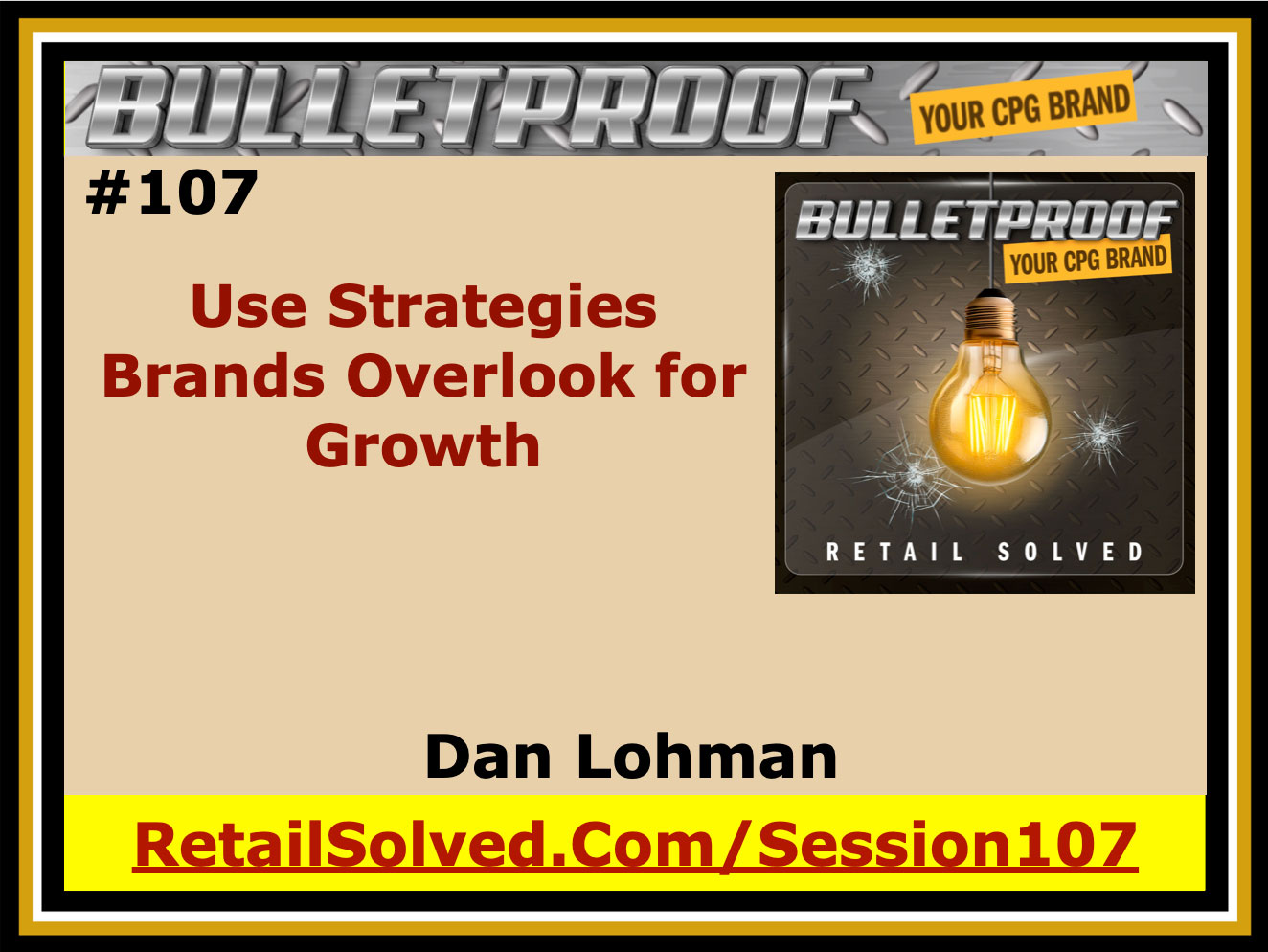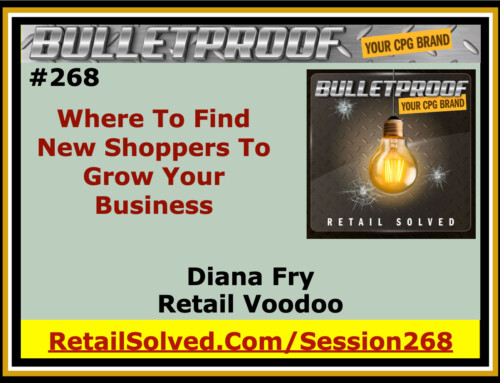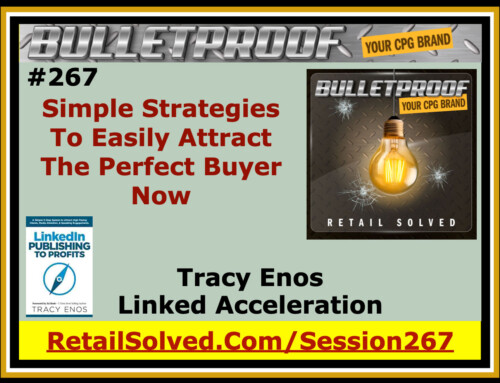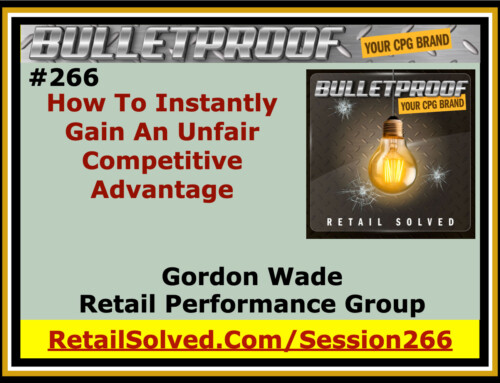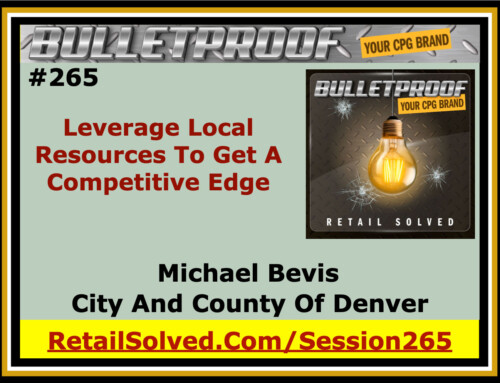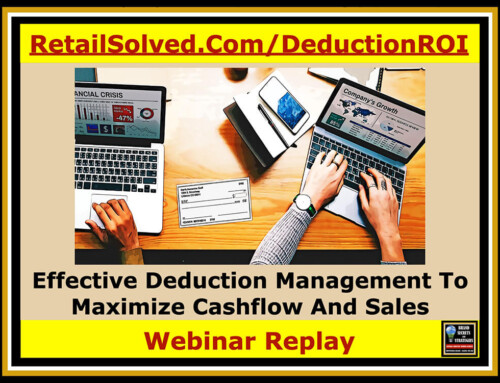Discover how to use strategies brands overlook for innovative sales techniques that drive growth and enhance brand health. Understanding brand health, measured by category growth contribution, is crucial for small brands to differentiate themselves from larger ones. This involves increasing category contribution, optimizing distribution, and running targeted promotions.
You’re taught to use out-dated strategies every brand uses to sell your unique disruptive brand. Your sales strategies should be as innovative as you are. Knowing your brand health & leveraging it at retail is the best strategy for sustainable growth
Listen where you get your podcast
Important: Brand Secrets and Strategies has been rebranded to Retail Solved. Please swap all BrandSecretsandStrategies.com URL’s with RetailSolved.com. This is now the Bulletproof Your Brand podcast. Thank you for listening! BRAND SECRETS AND STRATEGIES PODCAST #107 Hello and thank you for joining us today. This is the Brand Secrets and Strategies Podcast #107 Welcome to the Brand Secrets and Strategies podcast where the focus is on empowering brands and raising the bar. I’m your host Dan Lohman. This weekly show is dedicated to getting your brand on the shelf and keeping it there. Get ready to learn actionable insights and strategic solutions to grow your brand and save you valuable time and money. LETS ROLL UP OUR SLEEVES AND GET STARTED! Welcome. I appreciate you for listening. Remember, this podcast is about you, and it's for you. The goal here is to help you get your products on more retailer shelves and into the hands of more shoppers. Remember, at the end of almost every single podcast, there's one free downloadable guide. I always try to include one easy to download, quick to digest strategy that you can instantly adopt and make your own, one that you can use to grow sustainable sales and compete more effectively. If you like the podcast, subscribe, share it with a friend, and please leave a review. To sell more and grow beyond other brands in your category, you need to use strategies they overlook. You've put your passion, your money, and energy into building your brand, and you should have access to affordable tools and strategies that actually work. Traditional retail is expensive, with brands using what I call push strategy where your checkbook is the most valuable resource in your arsenal. The old pay-to-play push strategies will not differentiate you on a shelf. They will not give you significant and competitive advantage. Generically speaking, retailers don't make anything. They sell other people's stuff. What they sell is real estate in the form the space that your product takes up on their shelf. They Achilles heel of big brands is that they are a complacent in their go-to market strategy. This is a huge opportunity for small brands to leverage these strategies to provide retailers with what they really want. Retailers want three things. More shoppers in their store, a competitive advantage in their market, and a reasonable profit. Brands that help retailers achieve these objects while gaining a significant and sustainable competitive advantage. Savvy retailers reward those brands with preferential merchandising, incremental promotions and reduced fees, the fees they charge other brands. I know this because I became a trusted and respected resource to these retailers, and these are just some of the results I achieved. Why does this matter? Small brands don't have the velocity to compete against big brands. Traditional category management tends to overlook small brands as a result. Your brand health includes your contribution to sustainable category growth. Small, health focused brands provides sustainable growth across most every category. In their absence, most categories would be down or declining. I proved this in the feature article that I wrote for the 2016 Category Management Handbook. There's a link to it on the podcast page of most every podcast episode. This is going to be the focus of the solo podcast episodes that you hear from me over the next couple of months. I have had the privilege of mentoring, advising, and working with hundreds of brands and retailers in all stages of development from pre-revenue to multi-billion dollars in sales across every channel. Over the past few years, many people shared with me their frustration that there was no specific training to address the coming challenges that they face. More specifically, how does a brand become something other than an ATM machine for retailers, distributors, brokers, et cetera? How does a brand maximize the amount of available resources they have to grow sales, to get more runway and to fuel their growth? Most of the education out there is designed around how to teach a CEO how to get additional funding. Well, this certainly is an important skill for every CEO to have. I believe that it's more important for a CEO, for a brand, to be able to learn how to do more with the resources they have. The sad reality is that despite all the great advice that's out there, over 80% of the natural brands in our space, fail within the first year. I'm committed to changing that, and that's one of the underlying reasons why this podcast exists. You're taught that your brand health means how much money you've got in the bank. Your brand health has absolutely nothing to do with how much cash you have in the bank. The real health of your brand is measured by the profitable growth it drives within the category. The real health of your brand it its ability to drive sales at a premium price. Premium products that are organic, gluten-free, allergy free, plant-based, et cetera, are driving the contribution in every category. This is what retailers really want. The health of your brand is measured by its contribution to the category in the form of sales and profits. This is critically important to every retailer. They want to know that if they place your product on their shelves, that it will increase products and shopper traffic. While other brands brag about their product's ranking the category, you need to focus on how your brand contributes more to sustainable growth in the category then they do. Understanding this and how to leverage these skills is the difference between growing your brand and being a perpetual fundraiser always having to have your hand out and looking for the next investor to fuel your growth. Let's face it, retail is expensive, it's pay-to-play, but have hope, there is a better way and it all beings with your brand's story. This is why I release my free turnkey sales story strategies course to teach you what you need to know to become an expert in your category, your brand, your competition, and in your retail partners. This is something that most brands overlook, even the big brands. I've used these strategies throughout my entire career to push around some of the biggest, most iconic brands on the planet. They work for me and they can work for you too. One of the benefits of being able to leverage your strategies is it also improves your ability to raise funds and get more qualified investors, something that every brand wants. I mentioned a minute ago that your brand health has absolutely nothing to do with your ranking in the category. Let me explain. You've been taught that all you need is a canned topline report and that that's going to impress the retailer. On the contrary, retailers want insights, actionable insights that they can't get from anyone else. Traditional canned ranking reports simply identify the volume that each brand has or what they sell on the category. The problem is this. Some brands promote their products all the time. This artificially inflates their value to the category. Let me explain. If you promote your brand heavily, then your sales in the category are going to rank really high. At first glance, you might think that that brand is really good and drives sales in the category when the reality is they're typically just pulling dollars out of the category. This is the exact opposite of what retailers really want. Another disadvantage of brands that do this is that they train customers to only buy products when products are on sale. I'll give you a quick example. Several years ago, cereal companies were finding it very difficult to be able to sell products when they weren't on sale. Cereal was very expensive, and what they did is they had deep discounts whenever they promoted the product. Consumers finally caught on. What happened was consumers would only shop the category when the products were on sale. I see things like this all the time especially in the supplement category or in the salty snack category or in the beverage category. How do these strategies affect your buying habits? Think about it. When you see a big sale on a category, do you stock up? Do you buy a lot more product than you would typically buy? It's estimated that well over 70% of all trade dollars or promotional dollars are wasted. The primary focus or objective of any promotion is to introduce your product to a new customer, not to reward an existing customer to buy your product. I covered this more in-depth in other episodes and other mini-courses, so back to the ranking report. At first glance, when you look at the products that are on a ranking report, you instantly pay attention to the brands that are ranked on top or the items that are ranked through the top of the list, but what you don't pay attention to is how many dollars, how many profitable dollars that item or that brand contributes to the category. That's the focus of this podcast. Knowing how to leverage his at retail is your greatest point of differentiation. If you can help the retailer drive profitable sales in the category, then you have a point of leverage to help when you negotiate for incremental distribution, preferential merchandising, and incremental promotional opportunities. This is the key way that you help get more runway out of your available resources. How do you measure this? Your brand health is measured by your sales where you have distribution. This is really important. ACV or all-commodity volume is something that you need to become familiar with. It's a very confusing topic, but I put in a special module in my How to Assess the Health of Your Brand mini-course where I go in-depth to discuss this important topic. ACV or all-commodity volume, the amount of sales that the retailer sells in their market. Let me explain. I live in Colorado. If you can imagine a map of the state of Colorado and where Denver is, draw a circle around that. That is the trade area for the Denver market. If you then take all the sales in the industry, CBG industry and add those up, that's the total market volume. Then, if you divide each retailer, then that becomes their share or their ACV within that market. Now, as you drill down further into the category and to the brand, et cetera, you use that ACV number as the benchmark, so let me back up a little bit. When I talk about ACV, all-commodity volume, what that means is that's the total sales. On a perfect world, every retailer would sell the exact same items, and their share of their market would be equal. In other words, they'd sell the same amount of baby food, the same amount of bread and everything else. Well, obviously, that's unrealistic but stay with me. This will make more sense in a minute. Anyhow, that's a benchmark. That's a line in the sand that every single retailer can draw saying that my ACV is 30%, 20%, whatever that number is. Now, now that you've got that line in the sand, that benchmark, now that you can compare the performance of every item category, brand, et cetera within that retailer, so if the retailer's ACV in the market is 30%, then again, in a perfect world, that retailer would sell exactly specifically not more, not less of 30% of every single item that is sold in the market. Now, we all know that different retailers sell different products. Again, this is simply a line in the sand. We use ACV to help guide us to help understand what is the opportunity. Again, I get more into this in some of the different mini-courses, but if you're performing above your ACV, then you have a negative opportunity gap meaning that you're exceeding the opportunity in that category, meaning that your sales are greater than your fair share or what the ACV is within that retail within the market, within that category. If you're fortunate enough to have a negative opportunity gap, then that's something you need to celebrate with your retailer to let them know that you're working hard to drive sales within their store, within their category. If you have an opportunity gap, meaning your sales are less than the ACV, that's the opportunity for you to grow, for you to gain more distribution, sell more products, et cetera. This is why understanding this important concept and understanding how this is tied to the health of your brand is all very important. I know this is really confusing. Even the big brands that I work with struggled to really understand this. That's one of the reasons why I developed the How to Assess the Health of Your Brand mini-course where I go in-depth in this, and I have illustrations, and I show you exactly how this works. Anyhow, back to the example. We use ACV as a line in the sand, as a benchmark. Let's say that retailer, the retailer we're working with, has a 30% ACV in the market. In a perfect world, then we should sell 30% of the pasta sauce in the market, 30% of Brand A in the market, et cetera. On the ranking report, one of the first things we're going to look at is, is your brand getting its fair share of sales in the category in the retailer in the market? That's the first thing we want to look at. Next, we want to look at your contribution. What is your contribution in the category? If your contribution is higher than other brands, if you're natural, organic, plant-based, et cetera brand, it most likely is, if your contribution is higher than the other brands, then how can we leverage out with the retailer to help the retailer grow more sales within the category so the retailer that we're working with can take sales away from other retailers within the market? Remember, at the end of the day, this is what they want. More sales in their category, more traffic in their stores. Back to ACV and why it's important. In a perfect world, your item would be sold in 100% of the retailer stores. That means that you'd have a 100% ACV. The reality is you probably have less than 100% ACV. If you have a higher contribution, you contribute more to the category, and yet your ACV is somewhat in the area of 30% or 40% or whatever it is but it's not 100%, that's an opportunity for you to maximize or grow your sales and contribute even more to the profitable growth of the retailer and the category that you're in. Here's another way of thinking about it. Imagine you're going fishing in a pond that has all different colors of fish. Your fish are the blue fish, and we've already established that your fish are the best fish. They provide the best nutrients, et cetera. Your fish are the fish that most customers want to buy, or put it a different way, your fish, the blue fish are the ones that are driving more profitable growth to the category and for the retailer. Now, as you're fishing, as you add more fish to the pond, more blue fish to the pond, that increases the opportunity for retailers to sell more. As the percentage of blue fish in the pond grows to the same level as the other more popular fish, the other brands, you now begin to compete on equal footing, so back on land, as we grow sales within a retailer, profitable sales, contribution you bring to the retailer, the next opportunity is to increase your distribution, to be able to grow your sales across more stores, to be able to help that retailer reach or even exceed their ACV in the market. I hope this all makes sense. Again, I dig even more into it in the How to Assess the Health of Your Brand mini-course. Back to the topic and why this matters. As you continue to promote, you dilute your brand, you dilute the contribution that you make to the category. This means that you need to have a good balance between when you promote and when you sell your products outside of a promotion. Remember, the more you sell your products outside of a promotion or not promoted, that's going to help you build your contribution within the category. The goal of every brand is to be able to sell their products when they're not being promoted. This is when you're going to make the most money as a brand, and when you're going to drive the most profit to the category for the retailer. Knowing this and understanding this is going to help you work with the retailer to drive sales in their category. In other words, blindly participating in every promotion a retailer asked you to be involved in or distributor, whoever it is, pulls valuable dollars out of a category, and it dilutes your resources. It dilutes your ability to drive profitable growth within the store. This goes back to where we started. A lot of brands think of their brand health as if they have enough money to pay for the slotting promotions, price reductions displays, deductions of marketing and the advertisements that retailers want. Most brands chalk this up to the cost of doing business. Sadly, most promotions lack creativity, focusing instead on unreliable and unsustainable strategies that don't grow sales. Remember, retail is a marathon. It's not a sprint. Being able to leverage your strategies is going to give you more runway and help you get more out of your available resources. This is why growing your contribution within the category that you play in, within the retailer that you're in is so critically important. Next, you want to increase your distribution. You want to make sure that you maximize each and every selling opportunity in each one of the retailer stores. This means that you have to have the right assortment on the shelf. You've got all the right product location. There's a lot involved in this, but the focus of this podcast is to help you understand that there's an opportunity for you to drive profit or growth in the category if you pay attention to these two things, which come back to knowing the health of your brand. The next thing you want to do is you want to have fewer and more targeted promotions, promotions that are more effective of getting your products into the hands of the shoppers that want them. That's why you continually hear me say that my mission is to help you get your products onto more retailer shelves and into the hands of more shoppers, teaching you how to increase your contribution in the category, and teaching you why it's so critically important that you have the right merchandising and the right distribution. Remember, customers can't buy your products if they can't find them. To recap, the reason this matters is small brands don't have the velocity to compete with larger brands. When you look at the ranking report, small brands don't have the deep pockets that allow them to promote at the same level as the big brands. Small, natural, organic brands are responsible for all sustainable growth across every category. When you know the health of your brand and you know what contributes to growing the health of your brand, increasing the health of your brand, then you can develop more accurate forecast and you can even predict sales and sales growth potential. You're able to focus on the unique value proposition that you bring to the retailer and help them understand that by supporting you, by helping you grow, your success will be amplified by helping them grow in the category and help them compete more effectively in their market. There's a huge opportunity for small, natural, organic brands to take a leadership role in the category. A category leader is any brand willing and able to step up and help guide the retailer to drive profitable category sales, bring more customers in the store by leveraging the unique consumer that your brand attracts. This is your single best point of negotiation when working with retailers and investors. Knowing the health of your brand is something that needs to be baked into your selling story. You need to celebrate it, and you need to be able to communicate accurately and consistently with every retailer, everyone in your sales funnel why your brand matters to that retailer. This is how you stand out on a crowd of Joe. This is how you become more than an ATM. By leveraging these strategies, you can get more out of your available dollars and this will help you grow more sustainable sales. The difference between doing this and not doing this is how long you're going to be in business. One week, one day, one month, one year, one decade, et cetera. This is exactly why I launched the How to Assess the Health of Your Brand mini-course. Your brand's future is dependent on its health. Retailers want brands that provide category growth and new customers. In the mini-course, you're going to learn how to assess the health of your brand and the health of your competitor's brands, gain the skill necessary to improve your brand health by focusing on the factors that matter most to your long term success. Differentiate your brand as a category leader, which might result in incremental merchandising and promotional opportunities. Make it easier for local shoppers to find your products. Be much more than an ATM machine to retailers, brokers, distributors and agencies. Gain incremental merchandising skills that your competitors lack giving you a sustainable competitive advantage. With persistence and flawless execution, retailers will begin to look to you for advice and counsel. You can learn more about the mini-course by going to brandsecretsandstrategies.com/brandhealth. You can also get there by looking at the courses tab on my website or in the podcast show notes. This week's free downloadable guide is sent to new item checklist, the recipe for success. This free downloadable guide outlines why these strategies are so very important to your success and to your future. You can download it on the Podcast show notes by going to brandsecretsandstrategies.com/session107. As always, thank you for listening, and I look forward to seeing you in the next episode. This episode's FREE downloadable guide New product innovation is the lifeblood of every brand. New products fuel sustainable growth, attracts new shoppers, and increases brand awareness. Know the critical steps to get your product on more retailer’s shelves and into the hands of more shoppers. CLICK HERE TO DOWNLOAD YOUR FREE STRATEGIC GUIDE: The Essential New Item Checklist - The Recipe For Success Thanks again for joining us today. Make sure to stop over at brandsecretsandstrategies.com for the show notes along with more great brand building articles and resources. Check out my free course Turnkey Sales Story Strategies, your roadmap to success. You can find that on my website or at TurnkeySalesStoryStrategies.com/growsales. Please subscribe to the podcast, leave a review, and recommend it to your friends and colleagues. Sign up today on my website so you don’t miss out on actionable insights and strategic solutions to grow your brand and save you valuable time and money. I appreciate all the positive feedback. Keep your suggestions coming. Until next time, this is Dan Lohman with Brand Secrets and Strategies where the focus is on empowering brands and raising the bar.
Enter your name and email address below and I'll send you periodic brand building advice, tips and strategies.
Sign up to receive email updates
FREE Trade Promotion ROI Calculator:
Click Here To Maximize Sales And Profits
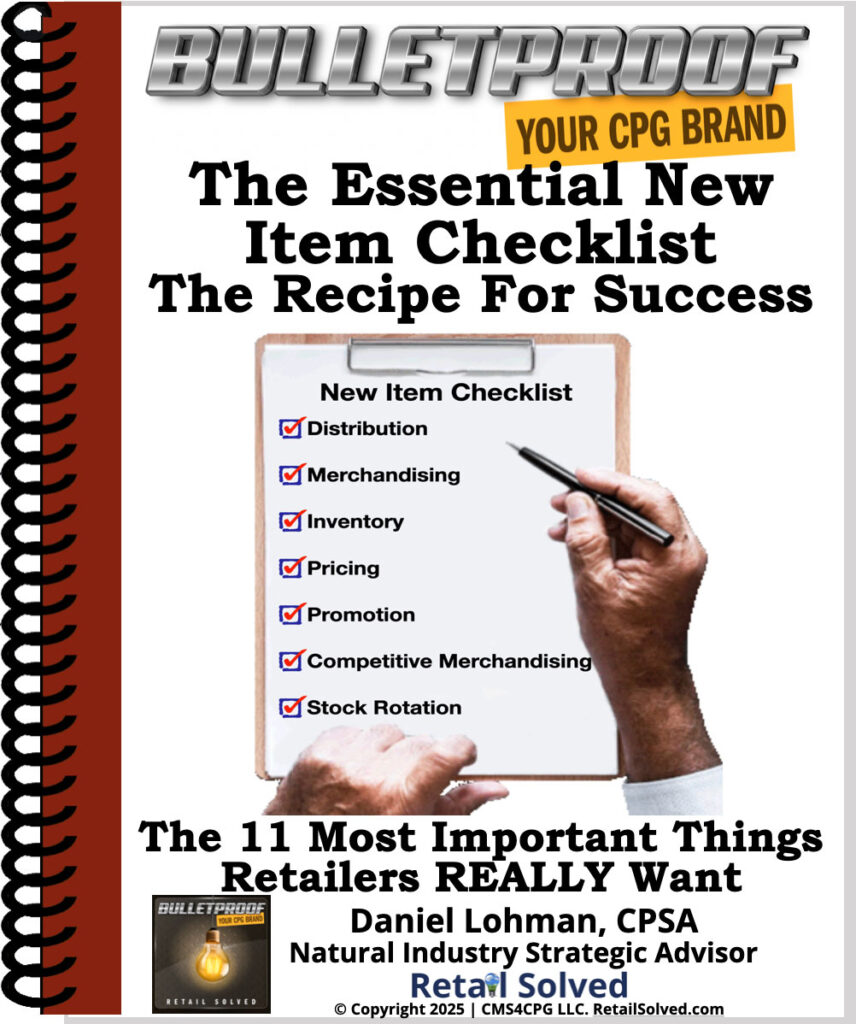
The Essential New Item Checklist – The Recipe For Success
Want A Competitive Edge? The Recipe For Success
New product innovation is the lifeblood of every brand. New products fuel sustainable growth, attract new shoppers and increase brand awareness. Learn the critical steps to get your product on more retailer’s shelves and into the hands of more shoppers. Maximizing your trade marketing can pour rocket fuel on your launch.
Image is the property of CMS4CPG LLC, distribution or reproduction is expressively prohibited.
